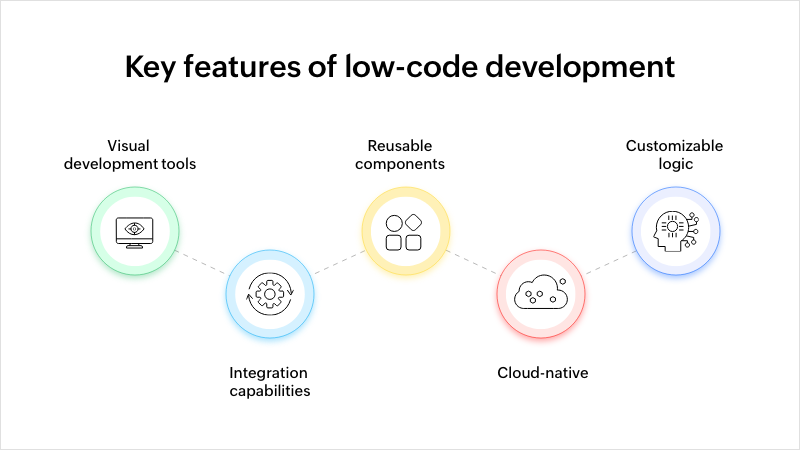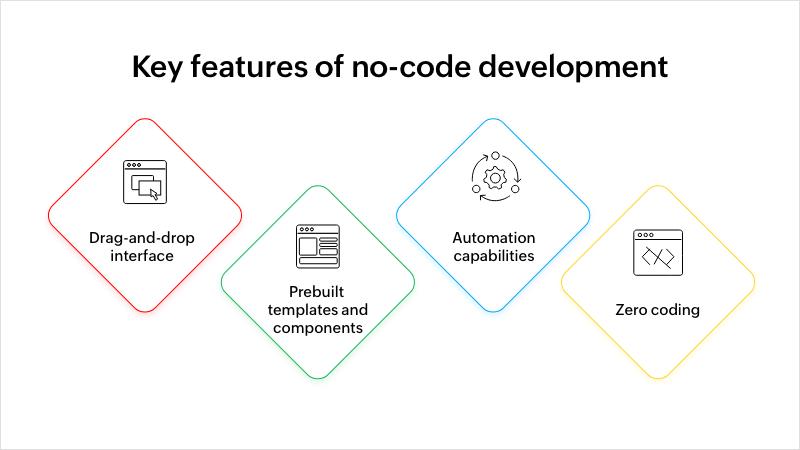- HOME
- Know Your Tech
- Understanding low-code vs no-code development platforms
Understanding low-code vs no-code development platforms
- Last Updated : August 6, 2025
- 12.9K Views
- 10 Min Read
What if your business could create custom applications in a matter of days, without the need for extensive coding skills? Low-code and no-code platforms are making this a reality, allowing teams to quickly design and deploy applications that fit their exact needs.
The low-code development market is expanding rapidly. In 2024, it was valued at $10.46 billion and is expected to reach $82.37 billion by 2034, growing at a CAGR of 22.92%. This significant growth shows the value of understanding how low-code and no-code platforms differ and which one best aligns with your business objectives.
These platforms enable businesses to create solutions quickly, giving teams the flexibility to build apps that solve immediate challenges and drive innovation. In this blog, we’ll take a closer look at the features, advantages, and potential drawbacks of both low-code and no-code platforms, helping you make an informed decision for your organization.
What is low-code development?
Low-code development is an innovative approach designed to simplify the application creation process. By using visual interfaces, drag-and-drop components, and prebuilt templates, low-code platforms significantly reduce the amount of hand coding required.
This enables both technical and non-technical users to create functional applications faster. Importantly, low-code platforms still provide the flexibility to add custom code when necessary, making them suitable for various business needs, from simple apps to complex enterprise solutions.
As businesses face growing demands for faster delivery and digital transformation, low-code development has become a go-to solution for many. Now that we understand what low-code development is, let's explore the key features that make this approach so effective.
Key features of low-code development
The goal of low-code platforms is to speed up and simplify app development without compromising flexibility. Here’s a breakdown of the features that make them so valuable for businesses:
Visual development tools: These platforms offer intuitive drag-and-drop tools that allow users to design applications without writing extensive code.
Reusable components: Many low-code platforms provide a library of prebuilt components, like forms, buttons, and templates, that help speed up the app creation process.
Customizable logic: Unlike no-code platforms, low-code tools allow users to insert custom code for more complex features, providing greater flexibility.
Integration capabilities: While not all low-code platforms provide built-in integrations, many offer connectors or API options to integrate with existing systems and databases, making them adaptable for various business needs.
Cloud-native: Most low-code platforms offer cloud-based deployment, ensuring scalability, ease of maintenance, and better security.

These technical features allow businesses to quickly develop and deploy applications while still maintaining flexibility for customization when needed.
Benefits and limitations of low-code development
Low-code platforms allow non-technical users to build apps, improve collaboration between departments, and significantly reduce development time. With intuitive design tools and prebuilt components, low-code solutions help businesses adapt to changing demands and foster innovation with minimal technical expertise.
Benefits
Faster development and time to market: Low-code platforms enable rapid application development, helping businesses deliver solutions more quickly and respond to market demands in less time.
Reduced dependency on IT: Business users can take ownership of the app-building process, allowing IT teams to focus on more complex projects.
Cost-effective: By reducing the need for highly specialized developers, low-code platforms lower the development cost, making them an attractive option for SMBs.
Flexibility: Low-code platforms offer room for customization, allowing businesses to build applications that meet their unique needs while still maintaining efficiency.
Limitations
While low-code platforms provide numerous benefits, there are some limitations to consider:
Adaptability for complex workflows: Low-code platforms are well-suited for most applications, but more intricate or specialized business processes may require additional customization. Advanced functionalities, such as custom workflows or complex data integrations, may take some time to fully master.
Scalability considerations: While low-code platforms generally perform well with moderate-scale applications, larger projects or high-volume data processing may require additional configuration to handle these complex needs effectively.
Security and compliance standards: While low-code platforms often include essential security features, ensuring they meet specific industry standards or compliance regulations may require additional configurations or third-party solutions.
Low-code is a valuable tool for many businesses, but for highly specialized or large-scale projects, it requires careful consideration.
Example of a low-code platform
Zoho Creator: An advanced low-code application development platform that enables businesses and individuals to easily build and deploy custom web and mobile applications with minimal coding.
Its user-friendly drag-and-drop interface, powerful scripting language (Deluge), and AI-driven features make it accessible to both business users and professional developers, speeding up the app development process by up to 10 times.
With over 7 million apps created, 30,000+ customers, and more than 6 million users, it's a trusted tool for driving success and helping everyone bring their ideas to life.
Interested in how low-code platforms can help you create custom applications? Explore how easy it is to start building solutions that meet your business needs.
What is no-code development?
No-code development platforms completely eliminate the need for any coding. Users can build applications by dragging and dropping components, creating workflows, and automating processes, all through an intuitive visual interface. No-code platforms are ideal for creating simple apps, automating tasks, and building business workflows, but they have limitations when it comes to customization and scalability.
Let's take a closer look at the core features of no-code platforms that differentiate them from low-code solutions.
Key features of no-code development
No-code platforms are designed to offer a completely code-free development environment. These tools are perfect for quickly building applications and workflows without requiring technical expertise.
Drag-and-drop interface: Users can easily build applications by dragging and placing preconfigured components. No coding knowledge is required, which makes it accessible to a wide range of users.
Prebuilt templates and components: Most no-code platforms come with an extensive library of templates and reusable components that accelerate the app creation process.
Automation capabilities: These platforms often include built-in automation tools, allowing users to create workflows and automate tasks with no code.
Zero coding: The core value of no-code is simplicity. Users can fully build applications without writing a single line of code, which makes it easier for business users to take charge of development.

The ease of use and speed at which applications can be developed make no-code platforms especially appealing for businesses looking to deploy simple applications quickly. However, as you'll see, there are significant limitations in terms of customization and complexity.
Benefits and limitations of no-code development
While no-code platforms drastically reduce development time and cost, they're best suited for simpler applications that don't require deep customization. Businesses with more complex needs may find them limiting in terms of flexibility and scalability.
Benefits
Speed: No-code platforms are designed to help you quickly create and deploy applications, often in a matter of hours. This can drastically reduce development time and speed up the delivery of solutions.
Ease of use: Even individuals with no technical experience can build functional applications, which frees up IT departments and reduces the need for specialized skills.
Cost-effective: Since no coding is required, businesses can save on development costs and reduce their reliance on developers.
Empower business users: No-code platforms allow business teams to create their own applications, enabling them to meet their specific needs without depending on IT.
Despite these advantages, it's important to recognize that no-code platforms have limitations that may impact their suitability for more complex or large-scale projects.
Limitations
Customization and control constraints: No-code platforms are designed for simplicity, so they may not support highly specialized functionalities. Without the ability to write custom code, you’re limited to the platform’s built-in features, which may not meet the needs of more complex business requirements.
Scalability: No-code platforms are best suited for smaller-scale applications. For businesses expecting significant growth or needing large, complex systems, no-code platforms may face limitations, as they're not designed for handling highly scalable or intricate operations.
Integration challenges: While some no-code platforms offer solid integration capabilities, integrating with existing enterprise systems can still be challenging for others, especially when dealing with legacy systems or highly complex workflows.
No-code platforms are perfect for businesses that need simple applications built quickly and at a lower cost. However, no-code may not be the best fit if your needs are more complex or require extensive customization. Let's explore some of the most popular no-code platforms available today.
Examples of no-code platforms
Bubble: This platform allows users to build web applications without any coding. It's well-suited for creating interactive apps with minimal effort.
Adalo: Focused on mobile app development, Adalo enables users to design and deploy apps without writing any code.
Webflow: A no-code platform for designing responsive websites, Webflow makes it easy for users to create sophisticated designs without programming knowledge.
While no-code platforms are ideal for businesses looking to build simple applications quickly and affordably, understanding when a more flexible solution is needed can be important.
Key differences between low-code and no-code development
Understanding the core differences between low-code and no-code platforms is important for deciding which one aligns with your business goals. Below is a detailed comparison that will help clarify when each approach is appropriate:
| Low-code | No-code |
Target user | Technical and non-technical users | Primarily non-technical users |
Customization | High customization with coding options | Limited customization, prebuilt workflows only |
Development complexity | Ideal for medium-to-complex applications | Best for simple apps, ideal for less complex needs |
Integration capabilities | Offers flexible integration with various third-party applications and legacy systems | Varies widely, with some offering robust integrations and others having limited options |
Development speed | Faster than traditional coding, with the efficiency of AI-driven platforms | Extremely fast, ideal for quick deployment |
Cost | Cost-effective for medium complexity projects | Highly cost-effective for simpler applications |
Security | Generally more secure with developer oversight and customizable security protocols | Potential security risks due to limited control over the underlying code |
Scalability | Suitable for scalable enterprise applications | Limited scalability for large projects or complex needs |
Governance & control | IT can enforce security, compliance, and version control | Harder to govern at scale; risk of shadow IT |
Learning curve | Takes some time to learn, but offers more power | Very easy to start, but less flexible |
What you can build | A wide range of applications, including internal tools, customer portals, mobile apps, process automation, and custom business systems. The flexibility depends on the platform's capabilities, with some offering more advanced features than others. | Primarily, simpler applications, like forms, surveys, approval workflows, and basic tracking apps. However, some advanced no-code platforms can support more complex use cases, such as basic CRM systems or automation tools, depending on their specific features. |
As the low-code market continues to grow, reaching a projected $50 billion by 2028, businesses increasingly turn to these solutions to stay competitive in the market.
Each platform has its strengths depending on your specific needs, whether you're looking for high customization or rapid deployment. As the demand for both low-code and no-code solutions grows, businesses that understand these differences can stay ahead of the curve and make smarter choices that drive long-term success.
When to opt for low-code over no-code platforms
Both low-code and no-code solutions were conceived to boost business agility and effectiveness, but they serve different segments in different ways. While no-code platforms have evolved rapidly to cater to the needs of micro, small, and medium-sized enterprises (MSMEs) and solopreneurs, their more customizable counterparts (low-code development platforms) have come to cater to enterprise needs as well, complementing increased enterprise SaaS adoption.
Businesses opt for no-code platforms to build simple applications that act as a standardized front to their end users, with low functional capabilities and customizability. Consider a situation where you'd like to deploy a simple post-event management app that collects feedback from participants and displays the results as a dashboard. In this case, no-code solutions might be just as capable as a low-code alternative.
But if, in addition, you'd like to selectively route users belonging to different satisfaction brackets to different teams to take further action, conditionally trigger responses, add users to different nurturing flows, or even push the feedback data to your CRM, you'd realize quickly that no-code platforms aren't your ideal option.
Simply put, you must factor in your business' long-term digital aspirations when selecting an app development platform. If you want simple, standardized, one-off applications, primarily for front-end needs, a no-code platform is the way to go.
Real-world example
Proovia, a logistics company, initially used spreadsheets to manage their growing fleet. As they expanded, they turned to Zoho Creator, a low-code platform, to build a custom solution for route optimization, driver management, and real-time tracking.
This allowed Proovia to scale from three to over 20 vans and improve customer satisfaction with real-time updates. The platform's flexibility helped them meet their specific needs without the complexity of traditional development.
This is just one example of how low-code platforms are perfect for businesses needing customization and scalability without extensive technical resources.
How these platforms are shaping the future of development
Low-code and no-code platforms are changing business software development by making it easier to create custom applications and automate tasks. These platforms enable teams to quickly build solutions with minimal coding, enhancing agility, reducing costs, and allowing businesses to scale efficiently without heavy reliance on developers.
Faster development: With intuitive interfaces and prebuilt templates, businesses can quickly create applications, reducing time to market and adapting swiftly to changes in the market.
Reduced IT dependency: These platforms empower non-technical teams to build their own solutions, reducing the need for IT involvement and streamlining the development process.
Scalability and flexibility: While low-code platforms excel in scalability for more complex projects, some no-code platforms are designed for smaller-scale applications. Businesses can easily adjust applications and add features, although scalability may be more limited for highly complex needs.
Cost efficiency: By lowering development costs and reducing the need for specialized coding expertise, low-code and no-code platforms help businesses cut both initial and ongoing development expenses.
Enhanced agility and innovation: These platforms promote a culture of innovation, allowing teams to quickly prototype, test new ideas, and stay competitive, responding to customer feedback in real time.
These platforms aren't just making development easier; they're helping businesses innovate faster, cut costs, and stay ahead in a rapidly evolving technological environment.
Enhance your business with low-code and no-code solutions
As businesses face challenges like limited IT resources and slow development cycles, the demand for flexibility has never been higher. Low-code and no-code platforms offer a practical solution by allowing teams to create custom applications with little to no coding, reducing reliance on IT and accelerating development.
 Rohith Krishnan S
Rohith Krishnan SRohith is a product marketer at Zoho. He writes about low-code, workflow automation and follows the latest digital transformation trends. Outside work he enjoys spending time with family, watching football matches and reading about futuristic trends, in no specific order.



